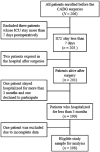Examining symptom trajectories that predict worse outcomes in post-CABG patients
- PMID: 30379108
- PMCID: PMC6399732
- DOI: 10.1177/1474515118809906
Examining symptom trajectories that predict worse outcomes in post-CABG patients
Abstract
Background: Coronary artery bypass grafting is one of the most common interventional revascularisation procedures used to treat coronary artery disease worldwide. With a wide variability in postoperative cardiac symptoms, identification of symptom trajectories during the 3-month postoperative recovery period may improve clinicians' abilities to support symptom recovery.
Aims: To identify distinct trajectories of cardiac symptoms seen over time in a cohort of patients during the 3-month post-coronary artery bypass grafting period, and determine clinical characteristics associated with different symptom trajectories postoperatively.
Methods: A prospective trial used the cardiac symptom survey to determine patient symptoms at baseline prior to surgery, and at 1 week, 6 weeks and 3 months following coronary artery bypass grafting. A latent class growth model and multivariate logistic regression analyses were used.
Results: Data were obtained from patients ( N=198) undergoing coronary artery bypass grafting in six medical centres of Taiwan, through patient medical records and interviews. Based on their frequency, trajectories were explored for the six most common postoperative symptoms including angina, dyspnoea, fatigue, depression, sleep problems and anxiety. We identified two to three distinct classes of trajectories for each symptom. Age, longer intensive care unit stay, fewer vessels bypassed, off-pump coronary artery bypass grafting, smoking history and lack of regular exercise were associated with worse symptom outcome trends over time.
Conclusions: Using this unique trajectories-based research method, we are able to achieve a better understanding of symptom recovery patterns over time among coronary artery bypass grafting patients. Recognising risk factors and potential recovery patterns prior to surgery may allow healthcare providers to deliver targeted discharge planning and individualised care after coronary artery bypass grafting.
Keywords: Symptom trajectory; angina; coronary artery bypass surgery; depression; fatigue; latent class growth model.
Conflict of interest statement
Figures
Similar articles
-
Coronary artery bypass grafting in high-RISk patients randomised to off- or on-Pump surgery: a randomised controlled trial (the CRISP trial).Health Technol Assess. 2014 Jul;18(44):v-xx, 1-157. doi: 10.3310/hta18440. Health Technol Assess. 2014. PMID: 25023641 Free PMC article. Clinical Trial.
-
Impact of malnutrition on postoperative delirium development after on pump coronary artery bypass grafting.J Cardiothorac Surg. 2015 May 20;10:74. doi: 10.1186/s13019-015-0278-x. J Cardiothorac Surg. 2015. PMID: 25990791 Free PMC article.
-
Influence of chronic kidney disease on early clinical outcomes after off-pump coronary artery bypass grafting.J Cardiothorac Surg. 2020 Jul 29;15(1):199. doi: 10.1186/s13019-020-01245-5. J Cardiothorac Surg. 2020. PMID: 32727495 Free PMC article.
-
Prior Percutaneous Coronary Intervention and Mortality in Patients Undergoing Surgical Myocardial Revascularization: Results From the E-CABG (European Multicenter Study on Coronary Artery Bypass Grafting) With a Systematic Review and Meta-Analysis.Circ Cardiovasc Interv. 2018 Feb;11(2):e005650. doi: 10.1161/CIRCINTERVENTIONS.117.005650. Circ Cardiovasc Interv. 2018. PMID: 29440275
-
Does off-pump coronary artery bypass graft surgery have a beneficial effect on long-term mortality and morbidity compared with on-pump coronary artery bypass graft surgery?Interact Cardiovasc Thorac Surg. 2014 Jul;19(1):149-59. doi: 10.1093/icvts/ivu075. Epub 2014 Mar 21. Interact Cardiovasc Thorac Surg. 2014. PMID: 24659552 Review.
Cited by
-
Predictors of health-related quality of life after coronary artery bypass graft surgery.Sci Rep. 2022 Sep 27;12(1):16119. doi: 10.1038/s41598-022-20414-1. Sci Rep. 2022. PMID: 36167788 Free PMC article.
-
Biopsychosocial Prognosis Scale for Coronary Artery Bypass Grafting - Brazilian Version: Adaptation and Content Validity.Braz J Cardiovasc Surg. 2025 Feb 12;40(1):e20230371. doi: 10.21470/1678-9741-2023-0371. Braz J Cardiovasc Surg. 2025. PMID: 39937633 Free PMC article.
-
Caregiver burden in informal spousal caregivers predicts psychological and physical health in patients following coronary artery bypass graft surgery: a longitudinal clinical cohort study.J Behav Med. 2024 Dec;47(6):1118-1126. doi: 10.1007/s10865-024-00512-3. Epub 2024 Aug 25. J Behav Med. 2024. PMID: 39183251
-
Prevalence of Depression in Coronary Artery Bypass Surgery: A Systematic Review and Meta-Analysis.J Clin Med. 2020 Mar 26;9(4):909. doi: 10.3390/jcm9040909. J Clin Med. 2020. PMID: 32225052 Free PMC article. Review.
References
-
- American Heart Association. Heart Disease and Stroke Statistics – 2010 Update. Dallas, TX: American Heart Association, 2010.
-
- Yuan T; Department of Health Executive. Main Causes of Death 2012. 6 June 2013. http://health99.hpa.gov.tw/TXT/HealthyHeadlineZone/HealthyHeadlineDetai..... (in Chinese) (accessed 21 October 2018).
-
- Redeker NS. Symptoms reported by older and middle-aged adults after coronary bypass surgery. Clin Nurs Res 1993; 2: 148–159. - PubMed
-
- Moore SM. Development of discharge information for recovery after coronary artery bypass surgery. Appl Nurs Res: ANR 1994; 7: 170–177. - PubMed
-
- DiMattio MJK, Tulman L. A longitudinal study of functional status and correlates following coronary artery bypass graft surgery in women [corrected] [published erratum appears in Nurs Res 2003; 52: 216]. Nurs Res 2003; 52: 98–107. - PubMed



